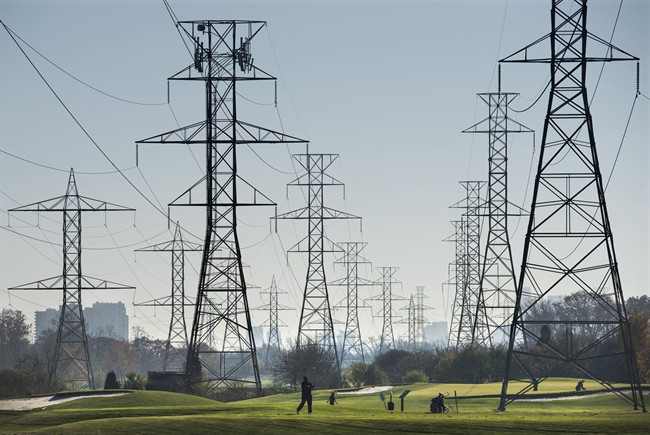The Ontario Energy Board (OEB), the arms-length regulator responsible for setting electricity prices in Ontario, is being urged by community groups from across the province to provide more detailed information on the number of customers affected by sky-rocketing hydro rates.

“We’ve had informal conversations with the OEB explaining just how helpful it would be to know the number of people in arrears with their electricity bills,” said Francesca Dobbyn, executive director of the United Way of Bruce and Grey County. “We’ve also asked them to provide data on the amounts people owe and the number of disconnection notices they send out annually.”
At present, the OEB requires utility providers to report the number of disconnections they perform each year. As first reported by Global News, this figure reached nearly 60,000 households in 2015. The OEB also requires utilities to report the number of customers behind on their electricity bills at the end of year, but they do not collect data on the number of disconnection notices sent each year, nor do they voluntarily share what information they have with aid organizations such as the United Way.
“From a planning standpoint it’s essential we have this information,” said Dobbyn. “Last year we spent about a third of our total budget on assistance with utilities. It was the first year we raised more than $1 million, but a huge chunk of that went straight to hydro and natural gas.”
Dobbyn says without more detailed information on the extent of energy poverty in Ontario, it’s difficult for organizations like hers to plan for the future.
“What are we supposed to do?” asked Dobbyn. “We don’t really know how much we’ll have to spend next year – we know it’ll be more – but we don’t know exactly how much.”
WATCH: High cost of hydro: crisis in rural Ontario

Dobbyn is not alone. Other advocacy groups such as the Low-Income Energy Network (LIEN) have been pushing the government for years to do more to assist low-income families struggling to meet their basic energy needs.
“We took the OEB to court over whether they had the jurisdiction to set lower rates for low-income people,” said Theresa McClenaghan, executive director of the Canadian Environmental Law Association and a co-founder of LIEN. “The divisional court ruled at the time that the OEB did in fact have the jurisdiction. And that when setting just and reasonable rates they need to take into account low-income needs and other factors driving people into energy poverty.”
In terms of collecting data on the number of residential customers behind on their bills, McClenaghan says she’s bewildered that the OEB isn’t doing more to assess the full extent of the problem.
“The fact that they’re not collecting the data at all just surprises me,” said McClenaghan. “It strikes me as central to determining whether people are suffering from energy poverty and just how effective assistance programs really are.”
WATCH: Sky-high hydro bills: Ontario energy minister says there’s no crisis

McClenaghan says that as a result of Global News’ ongoing investigation into sky-rocketing hydro rates in Ontario, LIEN has now assigned a full-time manager to conduct background research into price differences between rural and high-density areas of the province. The purpose of this research, says McClenaghan, is to determine the full scope of energy poverty in rural Ontario and to assess whether any possible legal recourses exist for customers struggling to pay steep delivery and distribution charges.
The clearest picture yet
According to a report released late last month by the United Way, community aid organizations in Bruce and Grey County spent nearly $700,000 last year assisting clients with utility needs, 58 per cent of this went directly toward overdue electricity bills. When staffing costs and other administration fees are added, the total figure spent on low-income energy assistance in Bruce-Grey was more than $1 million last year.
The United Way itself spent nearly $250,000 in direct funding helping low-income residents ward-off disconnection from their utility services. And while this figure includes some amounts allocated for natural gas, oil and firewood, the vast majority of these funds, too, said Dobbyn, was directed specifically toward electricity.
“We’re experiencing a real crisis in access to affordable electricity,” said Dobbyn. “I don’t think they [the OEB] fully understand the severity of the problem.”
Although optimistic the OEB is at least beginning to recognize there’s a problem in rural Ontario when it comes to rising electricity rates, Dobbyn admits her organization faces a difficult challenge when deciding how to best allocate what are essentially very limited resources.
WATCH: The high cost of soaring hydro prices in Ontario

“Energy poverty is just one of the many issues we confront on a daily basis,” Dobbyn said. “We need to triage our resources because come winter, it’s full-court press on hydro and preventing people from being disconnected.”
OEB seeks greater authority
Karen Evans, a spokesperson for the OEB, says the organization considers customer protection a top priority and that the OEB works closely with utility providers to ensure customer complaints are handled appropriately.
Beginning in 2017, Evans said, utility providers will be required to produce additional information meant to “test the effectiveness” of existing low-income assistance programs, like the Ontario Electricity Support Program and the Low-income Energy Assistance Program. But utilities will still not be required to provide information on the number of disconnection notices they send each year nor will they be required to provide current and up-to-date statistics on the number of customers behind on their electricity bills throughout the year.
The OEB is also seeking greater control over exactly when a customer may or may not be disconnected, Evans said.
Buried within an expansive government omnibus Bill known as the Burden Reduction Act, or Bill 218, these proposed measures would grant significant increases in authority to the OEB over disconnections.
“Bill 218 will give the OEB more tools to protect customers,” said Evans, who cites winter disconnections as an example of what might change should the Bill pass. “Currently, there is no legislation or regulation that prevents a utility from disconnecting a non-paying customer in the winter… the Bill will give the OEB more complete authority over disconnection by letting the OEB make rules saying when residential and small business customers cannot be disconnected.”
The Bill has passed first reading and is currently before the Ontario Legislature. Debate will resume on the Bill in September when MPPs return to Queen’s Park for the fall session.
Minister of Energy not responsible
Global News first raised the issue of energy poverty and rising electricity costs with Ontario Energy Minister Glenn Thibeault nearly two months ago. Since this time reporters from Global News have been in contact with the minister and his office on multiple occasions in an attempt to learn what possible measures, if any, Thibeault plans to take in order to address rising energy costs in the province – particularly in rural Ontario.
New to the position of energy minister, Thibeault initially promised he would look into the fact the OEB does not consider the number of disconnections and the amounts customers owe on their bills when assessing new rate increases.
WATCH: Extended Interview with Ontario Energy Minister Glenn Thibeault
But in a written response received this week, a spokesperson for the Ministry of Energy confirmed the minister has no intention of requesting the OEB to lower or reassess the affordability of hydro rates in the province.
“The OEB is an independent regulator with a mandate to protect the interests of Ontario ratepayers,” said the spokesperson. “It has an important role to play as a non-political, quasi-judicial regulatory body for the energy and electricity sector. We respect the authority and independence of the regulator and are confident that they will continue to take necessary steps to ensure utilities provide them the right information to make decisions in the interest of Ontario ratepayers.”
What this statement ignores, however, is that while the OEB is indeed an independent, quasi-judicial regulatory body, it was established by an act of government legislation – legislation that mandates the OEB protect Ontario’s ratepayers and ensure electricity rates in the province remain “just and reasonable” – a phrase that appears in the Ontario Energy Board Act 30 times.
The spokesperson’s statement also ignores that, under the Act, Ontario’s energy minister does have the authority to issue directives to the OEB with respect to fees and pricing. This authority includes the power to compel the OEB to, “take steps specified in the directive to promote fairness, efficiency and transparency in the retail market for gas and for electricity in Ontario.”


Comments